Countless large pits on a steep slope—what is their true nature?
Miyako City, Iwate Prefecture
Middle Jōmon Period (approximately 4,500 years ago)
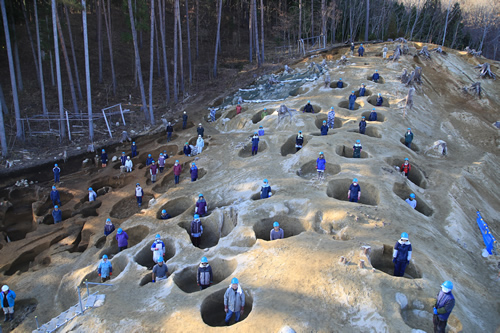
Storage pits densely cluster on the ridge top and the steep slopes on either side. The scale of the pits averages 2 m in diameter, and 1.5–2 m in depth. Large enough for a single adult to fit entirely inside, deeper pits were excavated by two people at once.
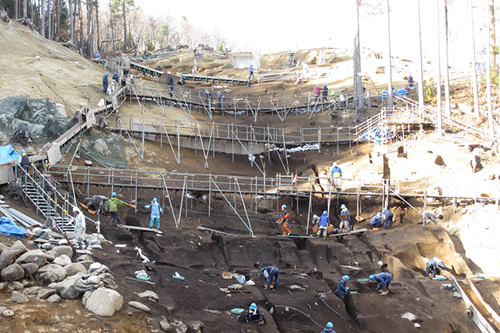
Excavation precinct seen from the bottom of the slope
This is a slope extending south from the ridge. At places where the slope is steep, the excavation was carried out using multiple scaffolds and belt conveyors. It is utterly amazing to think in what manner the Jōmon people continued making storage pits here.

Jōmon pot
Characterized by a pattern of large and small swirls. Rim diameter: 34 cm; vessel height: 48 cm.

The dark ditch-shaped feature at the center of the photo is the remains of a buried stream. The elevation of the site is approximately 100m at the highest point, and about 50m in the low areas.
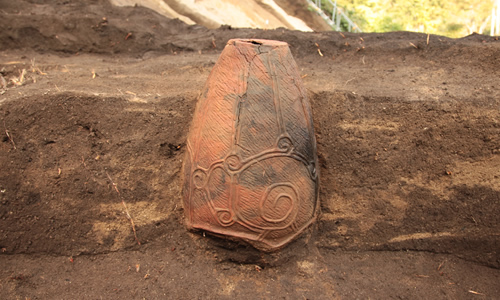
Interred pot
This was found within a pit structure. The pot was set with the rim pointing down, and the base coming close to the level of the structure’s floor. A hole of about 2 cm diameter had been opened in the center of the base, and it is regarded as a burial for a child.
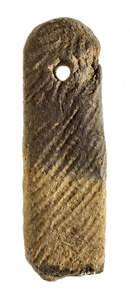
Axe-shaped baked clay object
Recovered from a pit structure. The use is not clear, and may be a ritual implement. Length: 10.5 cm.
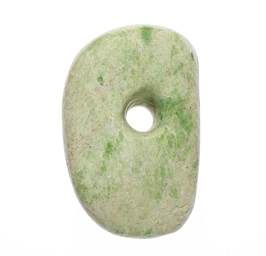
Pendant
The material resembles jade but is a different variety of stone. It was perhaps an item made as a jade imitation. Length: 4.5 cm.
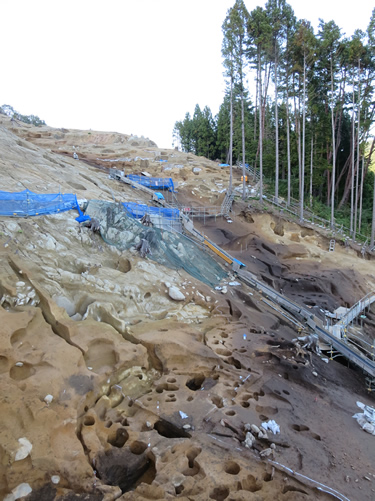
Pit structures and storage pits
Pit structures concentrate at lower places such as the lower ends of slopes or valley bottoms. This spatial composition is seen in common in the surrounding region.
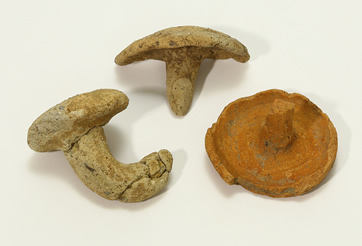
Mushroom-shaped baked clay objects
These items are found in Jōmon sites of the Tōhoku region, but their purpose is unclear. They are thought by some as possibly samples used for discriminating between edible and poison mushrooms. The item at center is 3.5 cm in height.
More than 500 huge pits
The Kōne site is located in the Yamaguchi district to the northwest of the urban area of the city of Miyako, at the edge of the hills facing the Yamaguchi river, a tributary of the Hei river. The excavation area is long in the north–south direction, including multiple ridges and the valleys enclosed between them, and the site as a whole has a difference in elevation of more than 40 meters. Excavations were carried out for three years from the 2014 fiscal year prior to work on the Sanriku coastal road as a reconstruction project.
As a result of these excavations, it was learned that this was the site of a large-scale settlement centering on the Middle Jōmon period. Among the main features found are approximately 100 pit structures, more than 500 storage pits (flask-shaped pits), and refuse areas for pottery. Centering on the refuse areas, large amounts of pottery, stone tools, and so forth were found. Among the recovered materials, in addition to rare items such as beads made of jade-like stone, and baked clay objects in the shapes of axes and mushrooms, there were discarded fish bones and shells included in the storage pits.
In the excavations attending the reconstruction project, there were multiple sites of the same period ascertained, but this site’s most salient characteristic was its location on a steep slope. There are many examples of storage pits on the tops of ridges and on the more moderate lower slopes, but previously cases of them extending over the steep slopes lying in between were nearly unknown. Also, this is a unique example within the prefecture of so many storage pits being concentrated together, and is rare even on a nationwide basis. As it is anticipated that the site extends beyond the excavation precinct as well, a considerable number of storage pits are thought to have been dug. While not all of the pits are from the same point in time, the continual digging of storage pits on this steep slope gives us a feel of the vigor of the Jōmon people of this era. (Nishizawa Masaharu)

